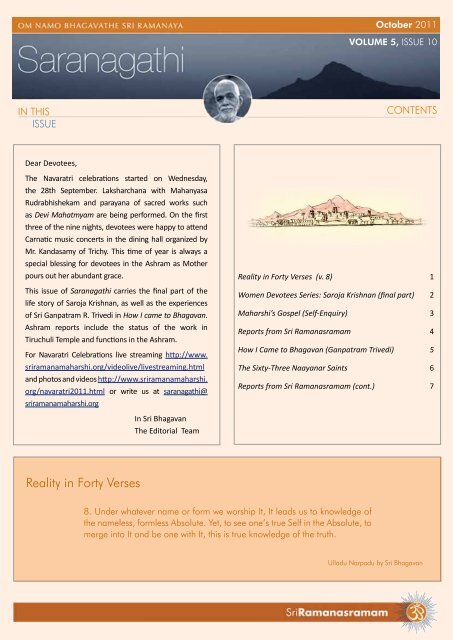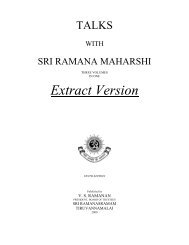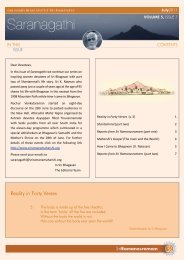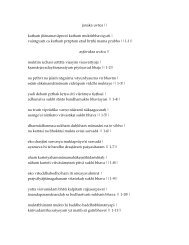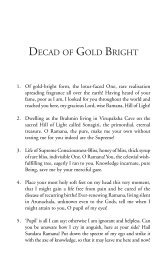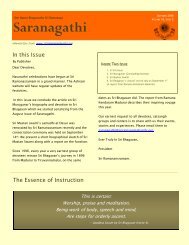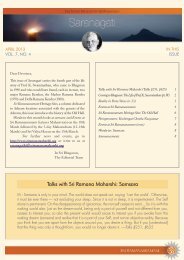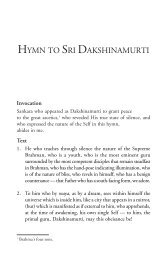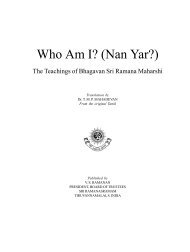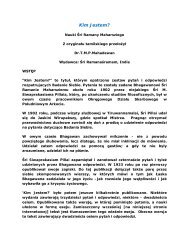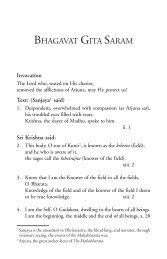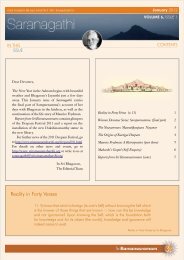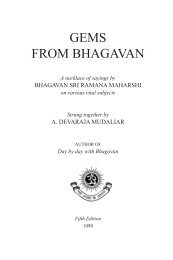October 2011 - The Bhagavan Sri Ramana Maharshi website
October 2011 - The Bhagavan Sri Ramana Maharshi website
October 2011 - The Bhagavan Sri Ramana Maharshi website
Create successful ePaper yourself
Turn your PDF publications into a flip-book with our unique Google optimized e-Paper software.
<strong>October</strong> <strong>2011</strong>VOLUME 5, ISSUE 10IN THISISSUECONTENTSDear Devotees,<strong>The</strong> Navaratri celebrations started on Wednesday,the 28th September. Laksharchana with MahanyasaRudrabhishekam and parayana of sacred works suchas Devi Mahatmyam are being performed. On the firstthree of the nine nights, devotees were happy to attendCarnatic music concerts in the dining hall organized byMr. Kandasamy of Trichy. This time of year is always aspecial blessing for devotees in the Ashram as Motherpours out her abundant grace.This issue of Saranagathi carries the final part of thelife story of Saroja Krishnan, as well as the experiencesof <strong>Sri</strong> Ganpatram R. Trivedi in How I came to <strong>Bhagavan</strong>.Ashram reports include the status of the work inTiruchuli Temple and functions in the Ashram.For Navaratri Celebrations live streaming http://www.sriramanamaharshi.org/videolive/livestreaming.htmland photos and videos http://www.sriramanamaharshi.org/navaratri<strong>2011</strong>.html or write us at saranagathi@sriramanamaharshi.orgReality in Forty Verses (v. 8) 1Women Devotees Series: Saroja Krishnan (final part) 2<strong>Maharshi</strong>’s Gospel (Self-Enquiry) 3Reports from <strong>Sri</strong> <strong>Ramana</strong>sramam 4How I Came to <strong>Bhagavan</strong> (Ganpatram Trivedi) 5<strong>The</strong> Sixty-Three Naayanar Saints 6Reports from <strong>Sri</strong> <strong>Ramana</strong>sramam (cont.) 7In <strong>Sri</strong> <strong>Bhagavan</strong><strong>The</strong> Editorial TeamReality in Forty Verses8. Under whatever name or form we worship It, It leads us to knowledge ofthe nameless, formless Absolute. Yet, to see one’s true Self in the Absolute, tomerge into It and be one with It, this is true knowledge of the truth.Ulladu Narpadu by <strong>Sri</strong> <strong>Bhagavan</strong>
So far as I know <strong>Bhagavan</strong> never did such things so it wasindeed quite remarkable. But <strong>Ramana</strong>tha Brahmachariand Muruganar were the great devotees of <strong>Bhagavan</strong> andsuch things were not uncommon with them.When I was in my teens, I used to sit in the hall andwatch the happenings around me: who came into the hall,what they had to say, what <strong>Bhagavan</strong> did and to whom hedirected his gaze. All these were matters of great interestto me. And I would feel elated and proud wheneverBhagvan’s gaze fell on me.One day I was seated near the second door betweenthe windows idly watching, as usual, when <strong>Bhagavan</strong>’seyes turned to me and rested there. <strong>The</strong> usual first feelingof pride and elation fell away and my eyes were lockedin his, unable to turn away. How does one describe theindescribable? Dark and wide, cool and bright, meltingwith mercy and kindness, those heavenly orbs seemedto expand and fill the room and all space, engulfing meand everything else. Time stood still. I can’t say how longI gazed like this. Looking back, I understand that this washis nayana diksha (initiation by sight). This has the powerto scorch all our vasanas and lead to freedom. I did notknow anything of this then, but merely felt happy. Surely<strong>Bhagavan</strong>’s look of grace never goes to waste. <strong>The</strong> seedwas planted and would surely bear fruit someday. Butwhen? That’s the burning question. So I wait.When I was young I used to ask <strong>Bhagavan</strong> to grantall kinds of paltry things that I deemed important at thetime. It was like begging a farthing from a billionaire. Ofcourse, the desired boon was granted each and everytime, but perhaps only out of pity for my utter stupidity.I don’t remember not getting the thing I wished for.One hot summer day during this period <strong>Bhagavan</strong>was sitting in the pandal. In those days a summer shelterfor the sake of coolness used to be erected between theeastern side window of <strong>Bhagavan</strong>’s hall and the well.On this day only a few persons were present, so I took<strong>Maharshi</strong>’s GospelSelf-EnquiryD: Does not the enquiry, ‘Who am I?’ turn out in the end an empty formula? Or, am I to put thequestion to myself endlessly, repeating it like some mantra?M. Self-enquiry is certainly not an empty formula; it is more than the repetition of any mantra. Ifthe enquiry, ‘Who am I?’ were a mere mental questioning, it would not be of much value. <strong>The</strong> verypurpose of Self-enquiry is to focus the entire mind at its source. It is not, therefore, a case of one‘I’ searching for another ‘I’. Much less is Self-enquiry an empty formula, for it involves an intenseactivity of the entire mind to keep it steadily poised in pure Self-awareness.page 3
this opportunity to ask <strong>Bhagavan</strong> something that I hadwanted to ask him for a long time. <strong>The</strong> truth is, it was alittle devious of me. You see, I knew that <strong>Bhagavan</strong> madeno distinction between men and women, that womenhad the possibility of meditation, samadhi and liberationas much as men. I knew how <strong>Bhagavan</strong> felt about this.But my mother-in-law, on the other hand, forbade meto do any dhyana saying that women should not domediation. I did not want to disobey my mother-in-lawbut if <strong>Bhagavan</strong> were to give his seal of approval then itmight make a difference with regard to her feelings aboutit. So I went and stood near him and said in a low voice,“Is it true that women should not practise meditation?”<strong>Bhagavan</strong>, who was sitting calmly, leaning on the cushion,suddenly lurched up and sat bolt upright and said in aloud voice, “Who said so?” It sounded like a roar and Iwas startled. Trembling, I murmured something andreturned to my place. When <strong>Bhagavan</strong> said, “Who saidso”, and with such firmness, it was as if he had set his sealof approval on the charter of women’s spirituality. Andnow I felt relieved because I had my own seal of approval.* * *My uncle Rajagopala Iyer is an outstandingexample of how <strong>Bhagavan</strong>’s grace continued to guidehis devotees even after he had shed his body. Myuncle was a very persuasive talker. He could talk youinto doing things even against your will; such was thepower of his words. He played a significant role in theshaping and writing of <strong>Bhagavan</strong>’s will and his is oneof the witnessing signatures. My uncle’s surrender to<strong>Bhagavan</strong> was total. Vexed at his incessant talking andits effects, his wife, Thangammal, and others, wouldremonstrate. But he would declare, “I fear no one. Ishall stop talking only when my <strong>Bhagavan</strong> bids me.”And it so happened that toward the end of hislife, Chithappa (uncle) had a vivid dream one night. Inthe dream, <strong>Bhagavan</strong> struck him with his stick saying“Keep quiet!” From that time onwards until his death,he preserved silence, showing no interest in anything,completely detached. I did not meet him then but Iheard the momentous news from devotees comingfrom Bangalore where Rajagopala Iyer was living withhis youngest son, <strong>Ramana</strong>n.Mahalakshmamma of Bangalore referred to it as amiracle, and indeed it was; his grand-daughter Ramaniconfirmed the news. In order to redeem his ardentdevotee, <strong>Bhagavan</strong> had bound his incessantly waggingtongue and stilled the ever roaming mind.* * *Many incidents in my life can simply be calledcoincidences. But I consider all of them <strong>Bhagavan</strong>’s leelaand grace. Finally, by his grace, <strong>Bhagavan</strong> returned meto the shelter of those beloved feet that he bade meclasp so long ago.Reports from <strong>Sri</strong> <strong>Ramana</strong>sramamOn the 18th September, <strong>Sri</strong> Gopal Krishna Gandhi—formerGovernor of W. Bengal, grandson of Mahatma Gandhi, grandsonof Rajaji and <strong>Ramana</strong> devotee—was at the Ashram to launch therecent Revolutionary Gandhi, Ashramite KVS’ translation of PannalalDasgupta’s Gandhi Gabeshana (Earthcare Books, Kolkata, <strong>2011</strong>).During his talk, Ashram President V. S. <strong>Ramana</strong>n hailed Gandhi as a manthat practised truth at every moment of his life. KVS spoke about thesalient features and unique aspects of the new book. Speaking last, <strong>Sri</strong>Gandhi said that Pannalal Babu seemed to have been an extraordinaryman, though it is sad that he should have been in jail in independentIndia, and yet, otherwise, such a book may never have been written,translated and launched from <strong>Sri</strong> <strong>Ramana</strong>sramam.page 4
How I Came to <strong>Bhagavan</strong><strong>Sri</strong> Ganpatram R. Trivedi, RajahmundryIam known as a bit of a talkative fellow in myfriendly circle. But till now, it has been a mysteryand a wonder that I could not open my mouth before<strong>Bhagavan</strong> all the times I visited the Ashram.My enthusiasm for ‘public life’ in my twenties hadbrought me into contact with many ‘big’ personalitieswith whom I always conversed freely and frankly. Butat no time and before no one did I feel so ‘small’ anddumb-founded as I did when sitting before <strong>Sri</strong> <strong>Bhagavan</strong>.<strong>The</strong>re are certain things in life the ‘why’ of whichone cannot always explain. So in my case also, it maybe that I am not able to offer any explanation as tohow I came to be attracted to <strong>Bhagavan</strong>. It has beenmy privilege to have come in personal contact withmany saints and spiritual luminaries of our time andmy personal intimacy with some of them was morethan normal. But it was the decree of the Divine that<strong>Ramana</strong> was to be my last resort.I visited <strong>Ramana</strong>sramam twice in February andDecember 1940. I would sit before <strong>Bhagavan</strong> in the oldhall, watching the routine, but I wonder, I never askedany questions nor exchanged any conversation with<strong>Bhagavan</strong>, who, I knew, was casting compassionateand graceful looks on me now and then. Now I thinkhe must have made me a captive by his glance of grace,or as my friend, <strong>Sri</strong> Chhaganlal Yogi, put it, ‘prey in hisjaws’, never to be abandoned; for ever since that time Ihave been an object of his grace in abundant measure.For long years after that I could not go to <strong>Sri</strong><strong>Ramana</strong>sramam. But when I heard about <strong>Bhagavan</strong>’sillness I was yearning to see him.I prayed to <strong>Bhagavan</strong> with all my heart to enable me tosee him early. It was a Friday and a function at Madraswas to begin the next day. I proceeded to Madras thesame day and took part in the celebrations but my mindwas at <strong>Ramana</strong>sramam all along. After the three-daypage 5
celebration, I immediately started for Tiruvannamalai.And indeed soon enough I found myself face to facewith the Master. Immediately I had the intuition that<strong>Bhagavan</strong> would cast off the mortal coil before long andthat this would probably be my last visit to <strong>Bhagavan</strong>.Like a dwarf trying to drink deep the infinite, I spentevery available minute in his benign presence.While taking leave after a stay of three days, I was takenby the Sarvadhikari inside the room where <strong>Bhagavan</strong> wasresting during the period of physical ailment. I prostratedbefore the master and with wet eyes begged leave ofhim. He looked at me with eyes full of compassion andspoke to me for the first time and for the last time in mylife. He spoke only one word. In Telegu, he said, “Sari”(meaning ‘well’ or ‘alright’). And so I withdrew.I went to the Ashram after <strong>Bhagavan</strong>’s Mahasamadhibut on each visit I found that although <strong>Bhagavan</strong> wasno more with us in the physical form, the same calmand peace, and <strong>Bhagavan</strong>’s charging consciousness, stillpervaded every inch of space in and around the Ashram.<strong>Bhagavan</strong> never claimed to perform any miracles nordo such things form a part of his line of sadhana. Butmiracles do take place and are almost inseparable fromthe lives of realised souls; for in their cases such miraclesare spontaneous and a part of Divine Will. Had theynot been too personal I would have mentioned severalinstances when his grace did me immense good.To most people who are physical-minded the Ashrammight at first sight appear to be ‘’without <strong>Bhagavan</strong>”,but a real devotee of <strong>Bhagavan</strong> in no time feels thatthe consciousness and grace of <strong>Sri</strong> <strong>Bhagavan</strong> are stillat work as much as ever before. We must only openout ourselves before him and try to become fit anddeserving objects of his grace. His message andteachings are immortal and will live on from Eternityto Eternity.<strong>The</strong> NaayanarsCourtesy of Ramalingar Pani MandramIn the famed town of Kadavoor lived a devotee named Kalaya. Day byday his heart melted with love for the Lord and he occupied himselfwith offering fragrant incense (kunkuliya doopam) to the Lord. But theLord in His grace made his devotee suffer from want while the latterengaged himself all the more in devotion. Slowly, however, Kalaya hadto dispose of all his possessions and he and his family often had tostarve for days at a time. Once when the pain of hunger became toogreat, his loving wife gave him her Thali—the auspicious golden symbolof marriage—and bade him sell it in order to procure rice. Withoutany qualm, he hastened on this errand. But on the way he met a mancarrying a load of incense, resin fit for the Lord’s service. Forgetting histask to find food, with a joyous heart he exchanged the gold ornamentfor the large consignment of incense and made his way to the temple.<strong>The</strong>re he engaged himself in singing the Lord’s praises and offeringincense. In the meantime, seeing his devotion, the Lord had Kubera,the God of wealth, flooded the devotee’s house with grain and rice ashis family slept. But his wife, roused by the Lord in a dream, saw theprofusion of food and at once set about cooking. Meanwhile, the Lordspoke to his devotee still at worship in the temple: ‘Get thee home, andappease thy great hunger with the feast that awaits you there!” (<strong>The</strong> 6thSeptember is Kunkuliya Kalaya Naayanaar’s aradhana day.)page 6
Reports from <strong>Sri</strong> <strong>Ramana</strong>sramam (cont.)On Tuesday, the 27th September, Yogambika was takenin procession around the Temple and installed in theMantapam in Mother’s Shrine. <strong>The</strong> following evening, the28th, women devotees sang Mother’s praises as the first of the‘nine-nights’ of Navaratri was celebrated in honour of GoddessMeenakshi. Gajalakshmi, Linga Puja, Venuganam, RishibhaVahanam, and Sesha Sayanam each in their turn would colourthe themes of successive nights. Tuesday the 4th <strong>October</strong> isSaraswati puja—worship of the goddess of learning and music.This day traditionally includes worship of books, where, informer times, books would be placed near <strong>Bhagavan</strong> as he saton his sofa. Nowadays books are placed beneath a photo of <strong>Sri</strong><strong>Bhagavan</strong> in Ashram Bookstall for the afternoon event.One Navaratri at Saraswati puja during <strong>Bhagavan</strong>’s time,books were arranged on the stool beside <strong>Bhagavan</strong> ashe sat on his sofa. Muruganar entered the hall and, uponseeing the pile of books with flowers strewn over them,was quite amused. He could not understand the need forany symbols of divinity when God Himself was seated in thehall. That’s why worship of books in <strong>Bhagavan</strong>’s presencestruck him as superfluous. He wrote in <strong>Ramana</strong> Purana, “Allancient texts and their expositions put together can be nomore than a preface to the Book of your Powerful Silence!”Where, he thought, is the need to worship a pile of booksin the very presence of the Repository of all Knowledge —<strong>Bhagavan</strong> <strong>Sri</strong> <strong>Ramana</strong>!Navaratri Today and in Former Times<strong>The</strong> Navaratri festival generally begins on the new moonbetween mid-September and mid-<strong>October</strong>. Thoughcelebrated in a grand manner everywhere in India,Navaratri has special significance for Tiruvannamalai: itis here that Parvati took the form of Durga and fought anine-day battle against the buffalo-demon Mahisha. Hervictory is commemorated on Vijaya Dasami (6th <strong>October</strong>,this year), the final day of the festival. For this reasonNavaratri in many parts of India is called ‘Durga Puja’.After Vijaya Dasami, Yogambika is ceremonially returnedto her abode in the inner sanctum and the womendevotees dance with joyful clapping and singing the circledance around Nandi in the Mother’s Shrine.page 7
Reports from <strong>Sri</strong> <strong>Ramana</strong>sramam (cont.)Old Dispensary RenovationBhuminatha Temple Inner PrakaraBhuminatha Temple RenovationOnce when his father scolded him, young <strong>Bhagavan</strong> took shelter in the shrine of Mother Sahayavalli behind her icon in theBhuminatha Temple. In the ancient past, over the course of incalculable centuries, others too took refuge in Sahayavalli andsought the Lord’s blessings at Bhuminatha Temple, not least among them, Lord Vishnu, Bhumidevi, Indra, Brahma, Surya, Gouthama,Nandi, Kanva Rishi and Cheraman Perumal Nayanar. Even to the present day, Mother Sahayavalli continues to look after her devotees.In August this year, at the behest of the Bhuminatha Temple authorities, a team of Ashram workers commenced a forty-day repairproject on the Temple mantapam. But counter to expectation they met with various obstacles, not least of all, the burning hotSeptember sun. More significant was the shortage of food they faced on a daily basis when political unrest developed in nearbyvillages. While Tiruchuli itself was not the site of any conflict, clashes intensified in neighbouring villages and looting began; therewere unfortunately even a number of fatalities. Police declared a curfew and though Tiruchuli remained peaceful, the village wasalso compelled to comply. So all shops were forced closed. Meanwhile Ashram workers carried on in their work. But when it cametime to take food, none was available, and all appeals were met with negative responses. Finally, even the modest request forjust a little rice gruel was also denied them. Just on the day when the situation became critical and it looked as if work could notcontinue, the unexpected grace of Mother Sahayavalli came to their aid: <strong>The</strong> Tamil Nadu Chief Minister’s Annadanam scheme forvisiting pilgrims of temples—announced a full decade earlier—was miraculously to take effect on that very day at Tiruchuli Temple.Within an hour food was served and Temple authorities saw to it that Ashram workers were given priority. What a contrast: fromno food to receiving a full sumptuous meal. In the days that followed, the temple management saw to it that Ashram workers wereproperly fed. <strong>The</strong> renovation was satisfactorily completed on schedule on the 20th of September.page 8Publisher: V. S. <strong>Ramana</strong>nsaranagathi@sriramanamaharshi.org


